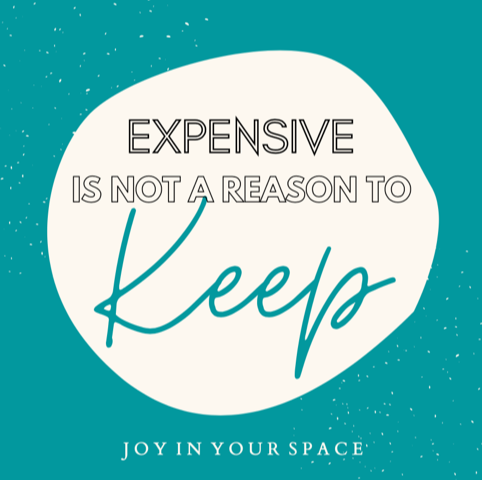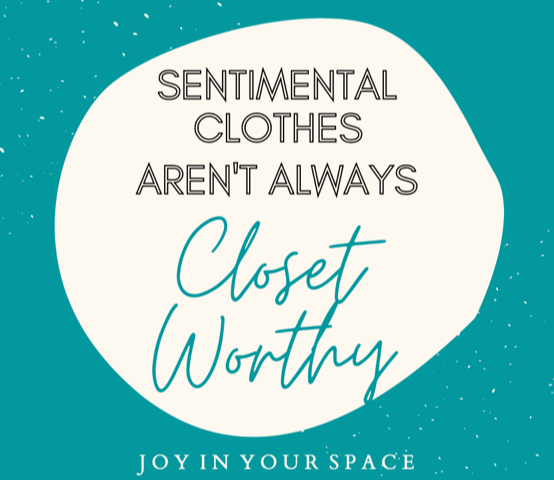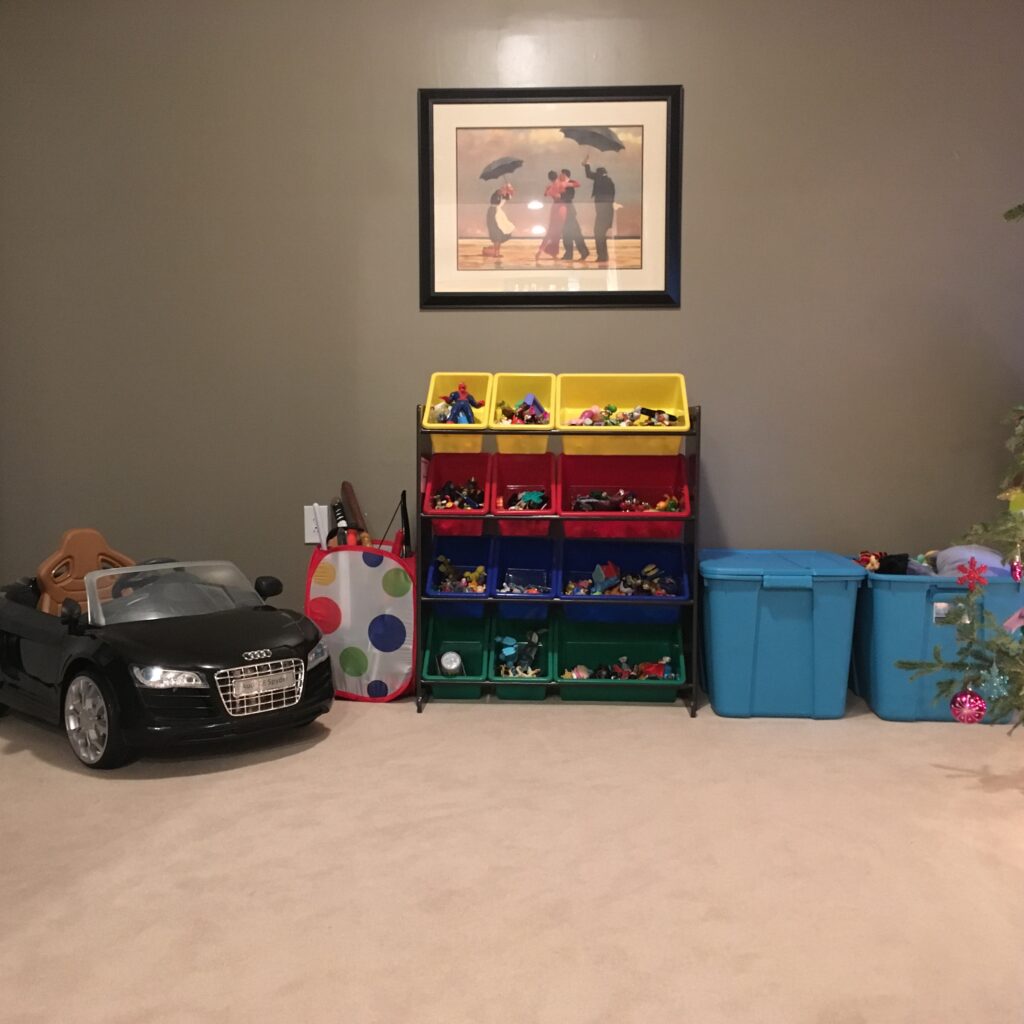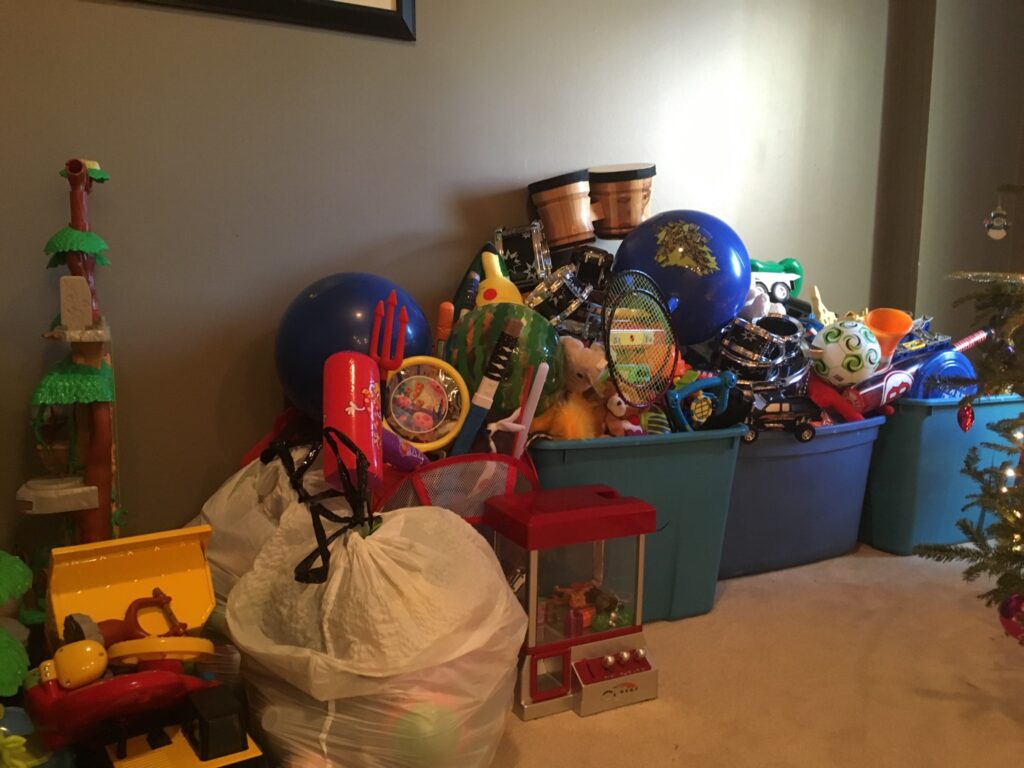By Kelly Galfand, JOY IN YOUR SPACE, 610-896-6896
My role as organizer usually involves helping people:
• live with less
• have more within easy reach
• love what they store.
One popular area I organize is wardrobe closets. Sometimes I’m hired to fix a physical problem; I solve storage challenges. Sometimes I am the necessary support as someone decides:
• what to keep
• where to donate or sell
• how to let clothes go.

In my experience, even when someone commits to trimming their wardrobe, there is one item they want to get rid of but (in their words) “can’t!” In these situations, what’s really behind their “can’t” is guilt.
When I hear a closet client say “I can’t get rid of this,” I know the clothing in question was either expensive, a gift, or it holds sentimental value.
• If the item was expensive… and they haven’t worn it (ever or enough), the struggle is about throwing good money away. But honestly, they’re wasting more money by storing this item. Waiting too long to resell something is not smart; the resale market pays more for recent purchases.
• Check out resale avenues like TheRealReal, PoshMark, Clothes Mentor, Plato’s Closet, and ThredUp depending on the item’s value.

• If the item was a gift… from someone they love, their love for the person is getting in the way of their ability to decide what they want in their life. They sometimes think that letting the item go is akin to rejecting the gift-giver’s love, kindness, or generosity. Trust me, your favorite aunt knows you love her even if you don’t love the winter hat she gave you. I always reassure clients that no one gives a gift in order to burden the recipient. A recipient’s only responsibility is to be gracious in accepting the gift.
• —You can always donate the item or its value to a charitable organization the gift-giver supports to lessen the pain of letting the item go from your life. Let it be a gift that keeps on giving — to someone else!

• If the item holds memories it will fall into one of two categories:
• Clothing from the person’s own life (even if it was someone else’s at some point)
When I come across these sentimental clothes, the first question I ask is: Will you still wear it? If the answer is “yes,” it can stay.
If the answer is “no,” then I suggest the t-shirt, wedding gown, or cheerleading skirt move to a spot more suitable to memories and nostalgia.
• Clothing that holds memories may have belonged to a deceased loved one. I help people navigate these sensitive areas often. What I counsel, is to keep only the sweatshirts, t-shirts, or hats that meant something to the departed and mean something still to you if you have room for it.
If it’s something you aren’t going to wear, display it to honor it in some way. Shadow boxes are wonderful conversation pieces and visual reminders of our ancestors’ legacies.
To me, your adored Uncle’s memory does not hinge on a single t-shirt…not even on his entire t-shirt collection. I recommend that if you let items go from your life (that belonged to someone you loved) decide how you will remember this person (in thought or deed) once you let the item go. Then be intentional in keeping their memory alive.

Infants grow fast — I’ve had piles of clothes to prove this fact. Nearly as fast as they’ve grown into their newest cute new outfits, they’ve outgrown them already! Having a plan for keeping up with this constant rotation will save you time in the future and reduce the stress of potential growing piles. Whether or not you hope to use the clothes for future children, here are a few quick-to-tackle tips for getting ahead of the clothing clutter.
Not saving anything? Get ahead of the clutter.
Determine the spot you’ll use for temporarily stashing outgrown items. I use a basket under my son’s crib, but you can use a paper bag, box, or large trash bag on a shelf or in a closet. The laundry room is a great place, too. From now on, every time you determine something no longer fits your child, put it in your temporary storage bin. Add to this bin until it’s full, then mark it with the approximate size(s), stick the box/bag in your car, and drop it off for donation. Likely you have friends with kids and could also drop off the box on a porch for hand-me-downs. More on donations at the end.
If you know you’ll be keeping some clothes for future children, read on.
Get Clothes Prepped for Future Kids
First, determine a spot you’ll use for temporarily stashing outgrown items. I use two baskets under my son’s crib, one for items I’m keeping and one for giving away, but you can use paper bags or boxes in the laundry room, on a shelf or in a closet, or large trash bags (clearly marked and stored out of reach of the littles), etc.
Next, Every.Single.Day and Every.Time you determine something no longer fits your child, decide if you liked this outfit/item and put it in the keep bin, if not, put it in your give-away bin. Add to these bins until full. Then transfer the give-away items to a box marked with the approximate size(s) and check out donation options below. For the clothes you’re keeping, transfer to a storage bin, vacuum sealed bag or other favorite storage solution. I tend to have extra diapers that are outgrown, so I fill diaper boxes with unused/outgrown diapers and clothing from roughly the same size. Taking 1 minute each day will save you the hassle of sorting through a huge pile later.
Options for Clothes You’re Not Keeping
Depending on your interest and time commitment, you have a few options in addition to those mentioned above. From approximately most to least time consumed:
Final Thoughts on Outgrown Clothing
It’s best to donate items you’d use again and toss anything too worn out. If your kids are older and aware of “favorite” pieces, go through this process with them, so they learn from you how to stay organized and be generous with their clothes! For the babies, an everyday, constant rotation keeps clothes that fit available and stops piles from accumulating to keep the nursery looking lovely.

By Adriane Weinberg, An Organized Approach, (215) 540 9401

Let’s admit it. We Americans have Too Much Stuff. And we don’t get rid of nearly enough. Reasons from clients include: it feels impersonal donating things to unknown people or they’re saving stuff for their kids (hey, your kids don’t want it). What if there were a way to give things away that feels good? There is! Buy Nothing groups.
The purpose of Buy Nothing Groups is to give away unwanted items, or request items that are wanted, for free. It’s based on the ancient practice of gift economies where people share and pool resources. The Buy Nothing Project started as a social experiment by two friends, Rebecca Rockefeller and Liesl Clark, in July 2013.
Groups are hyper-local and found on Facebook, which was chosen because it’s a free, widely used platform. The rules are simple. From their website, “Post anything you’d like to give away, lend, or share amongst neighbors. Ask for anything you’d like to receive for free or borrow. Keep it legal. No hate speech. No buying or selling, no trades or bartering, we’re strictly a gift economy.” Easy enough.
These ladies couldn’t have imagined that their little experiment would become a worldwide movement with 1.3 million users in 28 countries and 6,000 volunteers!
For more information or to find a Facebook group in your area, visit https://buynothingproject.org/. Rebecca and Liesl are currently crowdfunding to create a social media platform and app (https://www.soop.app/) to enhance “the power of shared abundance.” Their recently published book, The Buy Nothing, Get Everything Plan: Discover the Joy of Spending Less, Sharing More and Living Generously, shows people how to be a smarter shopper and get rid of things without adding to landfills.
On a related note, Buy Nothing Day is the Friday after Thanksgiving, aka Black Friday. It’s an international day of protest against overconsumption. This year, it’s Friday, November 27, if you’d like to participate.
I’m not anti-stuff. In fact, I have lots of stuff. My house isn’t cluttered, there’s ample space and I can find anything in seconds. For several years, a few years ago, I avoided shopping because I have what I need and much of what I want. I have enough. I don’t buy much anymore, unlike when I was acquiring things in my 20s, 30s and 40s. As a professional organizer, I know it’s about moderation and space. Everyone should do what feels right for their situation.
Many people lost jobs due to COVID-19. Buy Nothing Groups are a great way to save money. Or help neighbors save money by gifting things to them. Maybe you’ll be inspired to check out a Buy Nothing group.
In 2015 Forbes reported a Bureau of Labor statistic affirming that, in 1930, the average American woman owned 9 outfits. This, as opposed to a current day figure of about 30 outfits – one for each day of the month.
In 2016 a survey of 1,000 American women was conducted by ClosetMaid. It found that women only really like 10 percent of their wardrobe. It also found that one in ten women are depressed when they open their closet and 40 percent say that they don’t like any of their clothes.
As Americans, we are blessed with an abundance of choices when it comes to clothing and fashion. A broad variety of style, quality and affordability surround us. Yet, we can surmise from these two studies that, in the U.S., we have more clothing than ever before and are less satisfied with what we have. So where does the disconnect lie? How do we get from Point A – the clothing that we own; to Point B – happiness?

There are many explanations centered around the social and psychological motivations behind our large wardrobes and our dissatisfaction. Compulsive shopping, ecological reasoning, “retail therapy”, depression and loss are just a few theories offered.
The anxiety experienced when contemplating and processing the variety and abundance we face upon viewing our overcrowded wardrobes adds a real neurological strain. We end up starting our days stressed-out even before we walk out our front door.
Although it remains important to address the underlying reasons for overwhelmed and overwhelming closets and spaces, professional organizers (unlike therapists) also get the opportunity to directly address the physical issues as well. Addressing spacial congestion is empowering, encouraging a feeling of control over the environment, a feeling that can help ward off anxiety and depression.
Here are three simple tips for actions that you can take today that will make a difference every day.
Start with unused hangers and empty boxes that take up space for absolutely no reason. A dozen empty hangers can take up to a foot of space on your hanging rod – a whole foot! There may be many hiding between crowded garments so be sure to filter through everything. Next, begin at one end and review each garment. Remove all items that can be tossed or donated; toss the trash, then bag and label the rest for “Donation”.
Unless you live in a temperate climate where your entire wardrobe is versatile for year-round use, there are very few reasons to keep all of your clothing at hand in your closet all of the time. Separate items you are keeping into two seasonal categories: Fall/Winter and Spring/Summer. Keep the current half at hand in your closets and dressers. Store the other half in plastic bins or space bags. Take advantage of the seasonal switch to purge items that you no longer want before storing the rest.
Okay, I will admit that this may sound a little “organizer”-geeky, but try it out before you scoff. Imagine you are looking for your favorite pair of black pants. The ones that fit just right and aren’t too long or too short. Do you have to go in between all your tight spaces in your closet to find them before realizing they are at the cleaners? Not if your closet is color coordinated. You will simply go through the section of black pants. Not there? Then they are in the laundry. Need to put together a quick outfit? Easy to do when your eyes are simply matching colors and not hunting between randomly hung, tightly crammed fabrics.
Wishing is a good thing! It creates a vision of what we’d like for the future. Often the vision motivates us into action to make it come true. But the tricky part about a wish, compared to a goal, is sometimes we want our wish to magically happen without our taking action. Can you relate?
Here are some examples of Wishful Thinking that might be contributing to the clutter in your home:
The clothes you wish you could get into two or three sizes down.
The workout equipment you wish you would use.
The craft projects you wish you’d have to time to work on.
The second home you wish you could buy.
Charitable shops have been closed for some time due to the pandemic, and now that they’re opened, they are inundated with goods. Some people are reluctant to donate to charities for fear their items will be thrown in the trash. I’ve been told by Goodwill workers that they are storing items in trailers, however that statement is unverified. Another option for items you wish to sell or give away for free are websites like Freecycle.org and CraigsList.com, or local pages on Facebook Marketplace. Since summer is here, you can find ways exchange items with social distancing.
Wishful Thinking can be shifted to Realistic Thinking. If you have trouble getting started, consider the help of a professional organizer. Many are doing virtual organizing and can help you shift your thinking so letting go is easier. YOUR WISH FOR A CLUTTER-FREE HOME CAN COME TRUE!

Hello to all my Home Organizer friends!
Some people are intimidated about writing FaceBook posts and newsletters. I am not one of them. I find inspiration for FB posts and newsletters everywhere. For example, whenever one of my network friends posts something on FB or has an article in their newsletter that is relevant to my target market, I forward it to my Virtual Assistant and she posts it with a link their website. This helps build a rapport with my referral partners and gives me a wide variety of topics of interest to my current and prospective clients.
Home Organizers are all inspired by each other. Annette Reyman’s tag line “We get you moved in so you can move on . . . with life!” inspired my tagline “Let me help you catch up so you can keep up.”
I have attached a few photos that I plan to use as part of a future newsletter that will be tied in with my tag line. It will also be used as a FB post and a blog on my website.
The captions will read:
Problem: Samantha is a busy single mom who had never been able to carve out time to get her son’s playroom under control.
Solution: We purged the room of toys and books he had outgrown for four hours. Organizing was a breeze; it only took two hours.
Result: Cameron was thrilled to be able to play with his remote-control toys now that the controls are easy to find. He has taken ownership of his playroom and makes sure his friends and cousins help keep it tidy.
Testimonial: “I learned a different way of thinking. It’s OK to get rid of stuff and not be sad about it. Bobbie educated me with some valuable tips. For example, instead of putting all of my son’s small action figures in one big bucket, she suggested I buy an organizing unit where he can see all the figures and find the ones he wants. He has even categorized them himself!”
– Samantha, Langhorne PA
I also have fun with my FB posts and would like to share a draft for a future post. Perhaps it will inspire you to write something fun of your own.
How Loud is Your Clutter?
Does your clutter whisper, “Psst, I’m over here? I’m getting out of control.” Or does your clutter clear her throat and say “Ahem, over here bud. Pay me some attention.”
Ignore your clutter too long and it will scream out you, “Yo! You can’t ignore me any longer! I’m here, I’m out of control and you need to deal with me NOW!”
If your clutter is verbally abusing you, you need to call me! Let’s schedule a consult and quiet your clutter.

